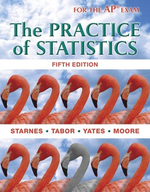Solution Found!
Radon detectors Radon is a colorless, odorless gas that is naturally released by rocks
Chapter 9, Problem R9.6(choose chapter or problem)
Radon detectors Radon is a colorless, odorless gas that is naturally released by rocks and soils and may concentrate in tightly closed houses. Because radon is slightly radioactive, there is some concern that it may be a health hazard. Radon detectors are sold to homeowners worried about this risk, but the detectors may be inaccurate. University researchers placed a random sample of 11 detectors in a chamber where they were exposed to 105 picocuries per liter of radon over 3 days. A graph of the radon readings from the 11 detectors shows no strong skewness or outliers. The mean reading is 104.82 and the standard deviation of the readings is 9.54. (a) Is there convincing evidence at the 10% level that the mean reading differs from the true value 105? (b) A 90% confidence interval for the true mean reading is (99.61, 110.03). Is this interval consistent with your conclusion from part (a)? Explain.
Questions & Answers
QUESTION:
Radon detectors Radon is a colorless, odorless gas that is naturally released by rocks and soils and may concentrate in tightly closed houses. Because radon is slightly radioactive, there is some concern that it may be a health hazard. Radon detectors are sold to homeowners worried about this risk, but the detectors may be inaccurate. University researchers placed a random sample of 11 detectors in a chamber where they were exposed to 105 picocuries per liter of radon over 3 days. A graph of the radon readings from the 11 detectors shows no strong skewness or outliers. The mean reading is 104.82 and the standard deviation of the readings is 9.54. (a) Is there convincing evidence at the 10% level that the mean reading differs from the true value 105? (b) A 90% confidence interval for the true mean reading is (99.61, 110.03). Is this interval consistent with your conclusion from part (a)? Explain.
ANSWER:Step 1 of 5
(a)
Given claim: Mean differs from 105
The claim is either the null hypothesis or the alternative hypothesis. The null hypothesis states that the population mean is equal to the value in the claim null hypothesis is the claim, then the alternative hypothesis states the opposite of the null hypothesis.
